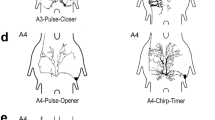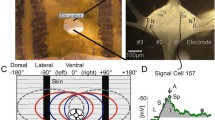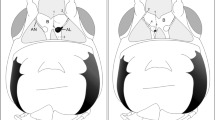Abstract
External mechanoreceptors and contact chemoreceptors on the cuticle of the sixth abdominal segment of locusts have divergent primary projections of their sensory neurons that form arbours in the segmental and anterior abdominal ganglia. Homologous interganglionic projections from adjacent segments converge in the neuropile of each abdominal ganglion. Of the contributing types of sensilla, three were previously unknown for locust pregenital segments: tactile mechanosensory hairs with dual innervation, external proprioceptors of the hairplate type covered by intersegmental membranes and single campaniform sensilla that monitor cuticular strain in sternites and tergites. In general, interdependence of motor coordination in the abdominal segments is based on a neural network that relies heavily on intersegmental primary afferents that cooperate to identify the location, parameters and strength of external stimuli.







Similar content being viewed by others
References
Altman JS, Tyrer NM (1977) The locust wing hinge stretch receptors. I. Primary sensory neurones with enormous central arborizations.J Comp Neurol 172:409–430
Bacon JP, Altman JS (1977) A silver intensification method for cobalt-filled neurons in wholemount preparations. Brain Res 138:359–361
Bayer EA, Wilcheck M (1980) The use of the biotin complex as a tool in molecular biology. Methods Biochem Anal 26:143
Bevan S, Burrows M (1999) Maps of the somata of efferent neurones with axons in the lateral nerves of locust abdominal ganglia. J Exp Biol 202:2911–2923
Berkowitz A, Laurent GJ (1996) Local control of leg movement and motor patterns during grooming in locusts. J Neurosci 16:8067–8078
Boyan GS, Williams JLD, Ball EE (1989) The wind-sensitive cercal receptor/giant interneurone system of the locust, Locusta migratoria. I. Anatomy of the system. J Comp Physiol [A] 165:495–510
Bräunig P, Hustert R, Pflüger H-J (1981) Distribution and specific central projections of mechanoreceptors in the thorax and proximal leg joints of locusts. I. Morphology, location and innervation of internal proprioceptors in the pro- and metathorax and their central projections. Cell Tissue Res 216:57–78
Bräunig P, Pflüger H-J, Hustert R (1983) The specificity of central nervous projections of locust mechanoreceptors. J Comp Neurol 218:197–207
Brown AG (1991) Nerve cells and nervous systems. Springer, Berlin Heidelberg New York
Brown AG, Rose PK, Snow PJ (1977) The morphology of hair follicle afferent collaterals in the spinal chord of the cat. J Physiol (Lond) 272:779–797
Consoulas C, Kent KS, Levine RB (1996) Remodeling of the peripheral processes and presynaptic terminals of leg motoneurons during metamorphosis of the hawk moth Manduca. J Comp Neurol 372:415–434
Ferber M, Hustert R (1996) The locust abdominal receptor muscle organ: response characteristics and its role in the control of segmental distance. J Comp Physiol [A] 178:679–697
Gnatzy W, Hustert R (1989) Mechanoreceptors in behavior. In: Huber F, Loher W, Moore TE (eds) Cricket behavior and neurobiology. Cornell University Press, New York, pp 198–226
Hassenstein B, Hustert R (1999) Hiding responses of locusts to approaching objects. J Exp Biol 202:1701–1710
Hodgson ES, Lettvin JY, Roeder KD (1955) Physiology of a primary chemoreceptor unit. Science 122:417–418
Hustert R (1974) Morphologie und Atmungsbewegungen des 5. Abdominalsegments von Locusta migratoria migratorioides. Zool Jb 78:157–174
Hustert R (1975) Neuromuscular coordination and proprioceptive control of rhythmical abdominal ventilation in intact Locusta migratoria migratorioides. J Comp Physiol 97:159–179
Hustert R (1978) Segmental and interganglionic projections from primary fibres of insect mechanoreceptors. Cell Tissue Res 194:337–351
Hustert R (1985) Multisegmental integration and divergence of afferent information from single tactile hairs in a cricket. J Exp Biol 118:209–227
Hustert R, Gnatzy W (1995) The motor program for defensive kicking in crickets: performance and neural control. J Exp Biol 198:1275–1283
Lewis GW, Miller PL, Mills PS (1973) Neuromuscular mechanisms of abdominal pumping in the locust. J Exp Biol 59:149–168
Kalogianni E (1995) Physiological properties of windsensitive and tactile sensilla on the ovipsitor and their role during oviposition in the locust. J Exp Biol 198:1359–1369
Matheson T (1997) Hindleg targeting during scratching in the locust. J Exp Biol 200:1317–1325
Meier T, Chabaud F, Reichert H (1991) Homologous patterns in the embryonic development of the peripheral nervous system in the grasshopper Schistocerca gregaria and the fly Drosophila melanogaster. Development 112:241–253
Merritt D J, Whitington P M (1995) Central projections of sensory neurons in the Drosophila embryo correlate with sensory modalitity, soma position, and proneural gene function. J Neurosci 15:1755–1767
Pflüger H-J, Bräunig P, Hustert R (1981) Distribution and specific projections of mechanoreceptors in the thorax and proximal leg joints of locusts. II. The external mechanoreceptors: hairplates and tactile hairs. Cell Tissue Res 216:79–96
Rekowski C v., Hustert R (1991) Sites of tactile stimuli on the body of locusts determine defensive reactions. In: Elsner N, Penzlin H (eds) Synapse - transmission - modulation. Thieme, Stuttgart, p 67
Rose U (1997) Serotonerge Wirkungen und serotonerge Interneurone im abdominalen Nervensystem von Insekten. Doctoral thesis, University of Göttingen
Rose U, Seebohm G, Hustert R (2000) The role of internal pressure and muscle activation during locust oviposition. J Insect Physiol 46:69–80
Thomas JG (1965) The abdomen of the female desert locust (Schistocerca gregaria) with special reference to the sense organs. Anti-Locust Res Bull 42:1–22
Tousson E, Hustert R (2000) Central projections from contact chemoreceptors of the locust ovipositor and adjacent cuticle. Cell Tissue Res 302:285–294
Watson AHD, Pflüger HJ (1987) The distribution of GABA-like immunoreactivity in relation to ganglion structure in the abdominal nerve cord of the locust (Schistocerca gregaria). Cell Tissue Res 249:391–402
Zawarzin A (1912) Histologische Studien über Insekten. II. Das sensible Nervensystem der Aeschnalarven. Zeitschr Wiss Zool 100:245–283
Zawarzin A (1924) Zur Morphologie der Nervenzentren. Das Bauchmark der Insekten. Ein Beitrag zur vergleichenden Histologie (Histologische Studien über Insekten IV). Zeitschr Wiss Zool 122:323–424
Acknowledgement
We thank Silvia Gubert for her expert technical help with electron microscopy and dextran staining.
Author information
Authors and Affiliations
Corresponding author
Rights and permissions
About this article
Cite this article
Tousson, E., Hustert, R. External sensilla of the locust abdomen provide the central nervous system with an interganglionic network. Cell Tissue Res 325, 151–162 (2006). https://doi.org/10.1007/s00441-005-0106-z
Received:
Accepted:
Published:
Issue Date:
DOI: https://doi.org/10.1007/s00441-005-0106-z




